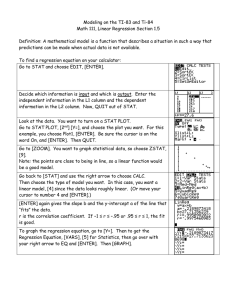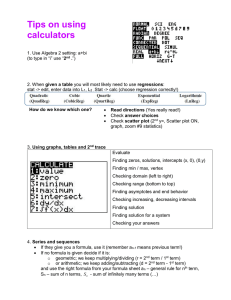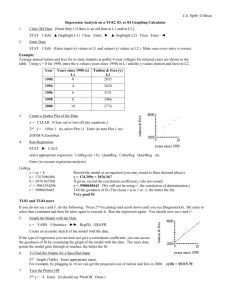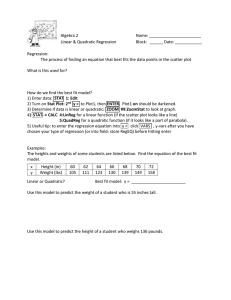Regression Equations on the TI-83
advertisement
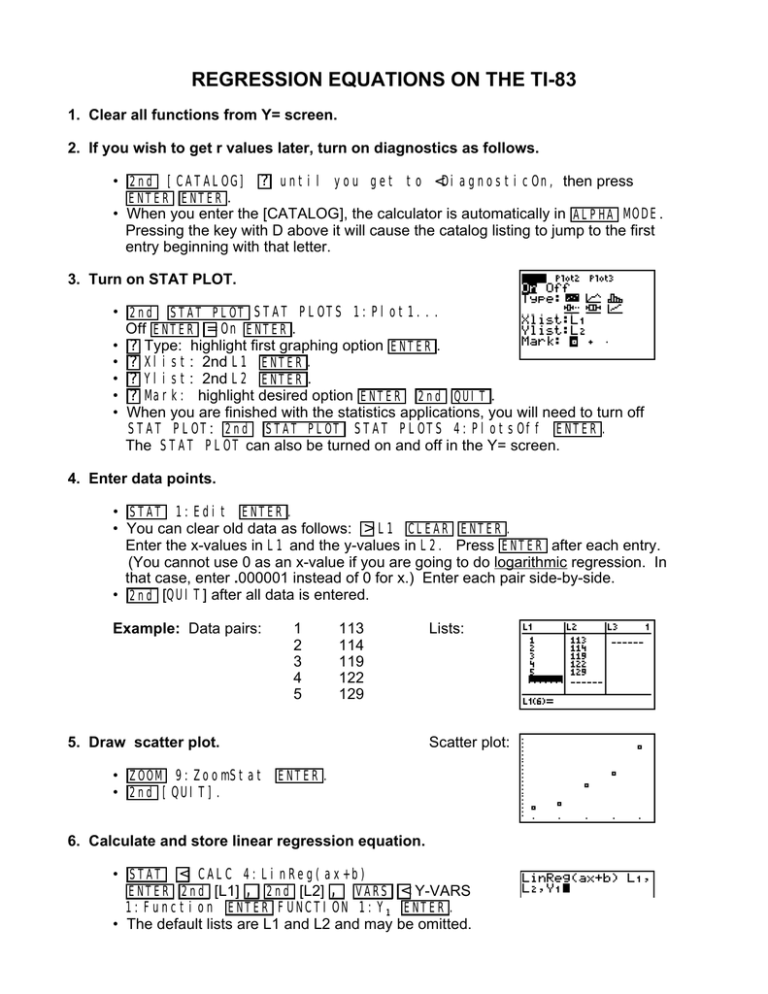
REGRESSION EQUATIONS ON THE TI-83 1. Clear all functions from Y= screen. 2. If you wish to get r values later, turn on diagnostics as follows. • 2nd [CATALOG] ? until you get to <DiagnosticOn, then press ENTER ENTER . • When you enter the [CATALOG], the calculator is automatically in ALPHA MODE. Pressing the key with D above it will cause the catalog listing to jump to the first entry beginning with that letter. 3. Turn on STAT PLOT. • 2nd STAT PLOT STAT PLOTS 1:Plot1... Off ENTER = On ENTER . • ? Type: highlight first graphing option ENTER . • ? Xlist: 2nd L1 ENTER . • ? Ylist: 2nd L2 ENTER . • ? Mark: highlight desired option ENTER 2nd QUIT . • When you are finished with the statistics applications, you will need to turn off STAT PLOT: 2nd STAT PLOT STAT PLOTS 4:PlotsOff ENTER . The STAT PLOT can also be turned on and off in the Y= screen. 4. Enter data points. • STAT 1:Edit ENTER . • You can clear old data as follows: > L1 CLEAR ENTER . Enter the x-values in L1 and the y-values in L2. Press ENTER after each entry. (You cannot use 0 as an x-value if you are going to do logarithmic regression. In that case, enter .000001 instead of 0 for x.) Enter each pair side-by-side. • 2nd [QUIT] after all data is entered. Example: Data pairs: 1 2 3 4 5 113 114 119 122 129 5. Draw scatter plot. Lists: Scatter plot: • ZOOM 9:ZoomStat ENTER . • 2nd [QUIT]. 6. Calculate and store linear regression equation. • STAT < CALC 4:LinReg(ax+b) ENTER 2nd [L1] , 2nd [L2] , VARS < Y-VARS 1:Function ENTER FUNCTION 1:Y1 ENTER . • The default lists are L1 and L2 and may be omitted. • The coefficients and r value are displayed on the home screen. • The regression equation is stored in Y1=. 7. Superimpose regression line on scatterplot. • ZOOM ZOOM 9:ZoomStat ENTER . 8. The correlation coefficient r. • The correlation coefficient r is a number between –1 and +1 that indicates the closeness of the fit of the regression line. The closer |r| is to 1, the better the fit. This line is a good fit, but there may be another type of regression that is better. 9. Using the regression equation to predict other y-values. • Example: To find y when x = 10: VARS < Y-VARS 1:Function ENTER FUNCTION 1:Y1 ENTER ( 1 0 ) ENTER • You could also store 10 as X and then evaluate Y1. • You could also use the graph and the 2nd CALC CALCULATE 1:value option. 10. Clearing an entire list of old data. • There are several methods for clearing old data, but one of the easiest is: STAT 1:Edit,use the up arrow > highlight the name of the list you wish to clear, then press CLEAR ENTER 11. Calculating other types of regression models. • Quadratic model: y = .714x2 – .286x + 112.4 (rounded to 3 decimals) • Cubic model: y = .714x2 – .286x + 112.4 Isn’t that strange!! • Quartic model: y = .5x4 – 6x3 + 25.5x2 – 41x + 134 • Natural logarithmic model: y = 9.206ln x + 110.585 • Exponential model: y = 107.933*(1.034x) • Power regression model: y = 110.799*x.077 Regression Equations on the TI-83 Judy Ahrens Pellissippi State Technical Community College January 30, 1999
